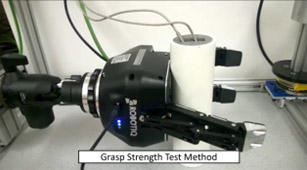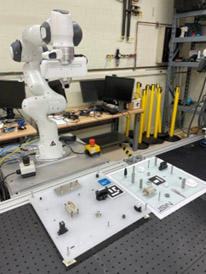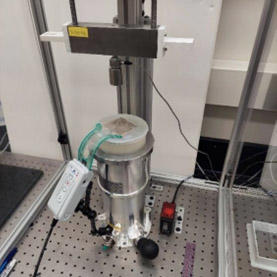Summary
The Grasping, Manipulation, and Contact Safety project will develop and standardize performance metrics, test methods, and associated measurement tools that support the development of robotic systems that have human-like dexterity and force-control characteristics. These types of robotic systems enable tactual-based safe human collaboration and contact-rich manufacturing operations, such as assembly, while addressing the barriers to automation faced by low-volume, high-mix manufacturing environments.

|

|
As collaborative robot systems continue to expand their presence on manufacturing floors due to their ability to work in close proximity with humans by limiting forces and pressures exerted on external objects, further research is needed to develop performance tests to validate that collaborative robot systems are indeed safe when deployed. Advanced grasping and manipulation technology is maturing and is closer to broader commercialization and adoption. Standardized test methods will help to further progress research and will lead to widespread characterization of macro-scale grasping and manipulation systems (part sizes greater than 1 mm, with accuracies greater than 25 microns). Such performance tests will address end-effectors, robot manipulators (including bimanual manipulation systems – i.e., two robots manipulating a single rigid object), robotic assembly systems, and physics-based simulation tools supporting contact rich robotic tasks.
Description
Objective

To provide performance metrics, test methods, and associated measurement tools to support next-generation robotic systems having human-like dexterity and force control characteristics.
Technical Idea
The force sensing and compliance capabilities used in collaborative robots to prevent injuries and enable them to work safely alongside human workers, as well as robotic end- effector technologies with advanced force control and manipulation are quickly evolving to support high-mix, low-volume manufacturing tasks. Examples include the use of passive or active compliance and force control for part insertion into assemblies or for adapting to part geometries while performing surfacing operations.
The project will continue long standing work and leadership within existing standards bodies focusing on industrial robot safety, and specifically within ISO/TC 299 on Robotics and ANSI/RIA R15.06 Subcommittee on Industrial Robot Safety, and will help develop new grasping and manipulation performance standards through ASTM International Committee F45 on Robotics, Automation, and Autonomous Systems. Using unique testbeds and the development of metrics, test methods, artifacts, and measurement tools, the project will support safe human-robot collaboration and will help gauge the performance of robotic grasping and manipulation.
Research Plan
- Develop soft sensing technologies (e.g., MEMS-based sensors embedded in bio-fidelic elastomers), performance test methods, and supporting test devices to increase the accuracies of robot contact force and pressure measurements for comparison with biomechanical limits during collaborative robot applications using power and force limiting (PFL) functionality.
- Continued efforts to support ISO/TC 299 WG3 on Industrial Robot Safety and ISO 299 WG8 on Validation Methods for Collaborative Applications through the development of measurement science to support the development of safety standards.
- Lead efforts within ASTM International sub-committee F45.05 on Grasping and Manipulation to develop performance standards for bi-manual robot manipulation.
- Lead the development of a suite of robotic hand grasping and manipulation elemental performance metrics, test methods, and terminology within ASTM International sub-committee F45.05 on Grasping and Manipulation, with supporting testbed implementations.
- Lead the development of an ASTM F45.05 suite of standards supporting Grasp-type end-effector technology performance metrics, test methods and assembly task boards representing tasks performed in the manufacturing industry.
- Develop measurement science needed for benchmarking a robot’s assembly capabilities when performing insertion-based tasks, as measured by applied-force vs. time-to-completion. Investigate and implement commercial-off-the-shelf (COTS) robotic insertion technologies and use the developed measurement science to benchmark performance over many systems.
- Develop physical test methods and validation guidance for physics-based simulation tools used to support contact-rich robot tasks. Perform literature search on current simulated environments and methodologies for measuring their performance.
- Develop robotic perception and manipulation assets to support machine learning research in manufacturing applications including a synthetic image data pipeline for training vision-based robot systems and an accompanying image dataset of manufacturing parts.
Major Accomplishments
Standards Development
- Established ASTM International sub-committee F45.05 on Grasping and Manipulation
- Assembly task boards
- WK87214 Standard test method for robotic assembly task boards: Benchmarking performance
- WK87213 Standard practice for robotic assembly task boards: Recording assembly test configuration
- Grasp type end-effectors
- WK83863 Grasp-Type Robot End-Effectors: Grasp Strength Performance
- WK86189 a Split Force Measurement Apparatus to Support Grasp-Type End-Effector Performance Tests
- ISO/TC 299 on Robotics
- Assisted in the development of ISO TS 15066 Robots and Robotic Devices - Collaborative Robots within working group 3.
- Assisted in the development of ISO PAS 5672:2023 Robotics – Collaborative Operations – Test Methods for Measuring forces and pressures in human-robot contacts within working group 8.
Datasets
- Designed and fabricated the publicly available NIST Manufacturing Objects and Assemblies Dataset (MOAD) data collection system
(dataset and fabrication replication available at https://www.robot-manipulation.org/nist-moad)
Related Recent Publications
- Kimble, Kenneth, et al. "Performance measures to benchmark the grasping, manipulation, and assembly of deformable objects typical to manufacturing applications." Frontiers in Robotics and AI 9 (2022): 999348.
- Falco, Joseph, Karl Van Wyk, and Kenneth Kimble. "Advances in Robot Technology Supporting Low-Volume/High-Mix Small Part Assembly Operations." (2022).
- Kimble, Kenneth, et al. "Benchmarking protocols for evaluating small parts robotic assembly systems." IEEE robotics and automation letters 5.2 (2020): 883-889.
- Falco, Joe, et al. "Benchmarking protocols for evaluating grasp strength, grasp cycle time, finger strength, and finger repeatability of robot end-effectors." IEEE robotics and automation letters 5.2 (2020): 644-651.
- Case, Jennifer C., et al. "Towards the development of soft force and pressure sensors for robot safety applications." 2021 IEEE Sensors. IEEE, 2021.
- Sun, Yu, et al. "Research challenges and progress in robotic grasping and manipulation competitions." IEEE robotics and automation letters 7.2 (2021): 874-881.

